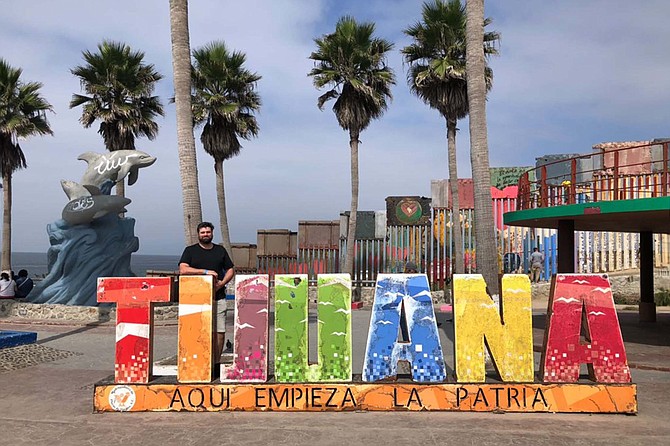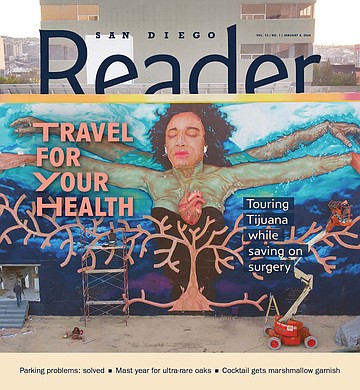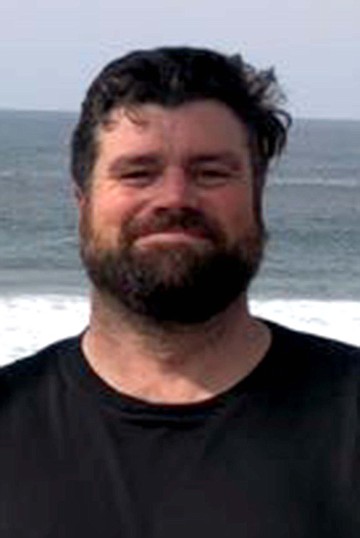 Facebook
Facebook
 X
X
 Instagram
Instagram
 TikTok
TikTok
 Youtube
Youtube

The message arrived via my Tijuana Adventure Instagram on a Friday afternoon: “Any chance of a tour tomorrow?” A bit short notice, but I was free and quoted the fellow my price, which proved acceptable.
“I’m in Tijuana at Oasis of Hope Hospital. Start at 11 am?”
I asked him what his interests were and where he was visiting from.
“I’m from New Zealand,” he replied. “I’ve never been overseas, apart from Australia. I’ve only been in USA and Mexico for two days. I would love to get to see the border up close. Chill out, walk a street market, buy some souvenirs for my kids, and have a couple of beers.”

Some might think 11 am a little early for beers, but I ty to give the customer what he wants, and so I agreed. In my decade of doing tours in Tijuana, I had toured people from all over the world, but never a Kiwi. The next day, I arrived at Oasis of Hope fifteen minutes late and met up with my client, Ben Perry. A former rugby player, Ben stood tall and burly. He could barely fit in my car. I could barely understand his accent.
Showing him the border up close was an easy task. The border wall extending into the ocean in Playas de Tijuana is just a few blocks from Oasis of Hope. As Ben jumped in the passenger seat, I apologized for the condition of my car (old and dirty). I parked behind the Plaza de Toros Monumental and we walked to the border wall. Ben took a smiling stand at the boundary marker that officially divides the countries, one foot in Mexico and another in America.
Breakfast was also easy: Tacos Aaron, which makes some of my favorite breakfast tacos varios in Tijuana, was just around the corner from Oasis of Hope. I showed Ben the menu at the taco truck and explained what tacos varios are. Ben simply instructed me to get what I liked. I got us two tacos each: one birria, the other chile relleno topped with huevos en salsa. It was his first food in 14 hours, and he said it was the best thing in the world.
After breakfast, I drove him around the city, showing him the sights and narrating Tijuana stories. I drove him by the Xolos soccer stadium, through one of Tijuana’s richest neighborhoods, and past Hipodromo Caliente. As we passed it, I related some of the eccentric myths surrounding Jorge Hank Rhon, owner of the largest casinos in Mexico. I commented on Tijuana’s exponential growth as we drove past some new developments. Around 1 pm, we settled in Teléfonica Gastro Park for lunch and beers.
By this point, I had gotten used to Ben’s accent, and as we sipped our beers, I asked what brought him to Tijuana. “The trip is mainly for my wife’s gastric sleeve,” he said. It turned out she wasn’t the first Kiwi to make the trek: three of her friends had done it before her and recommended the journey.
Plenty of Americans travel to Mexico for affordable healthcare, and Tijuana is a top choice. As soon as you cross the border, there are dozens of pharmacies, clinics, and hospitals. Kiwis doing the journey is less common, but not unheard of. Despite New Zealand’s universal healthcare, it can be difficult to get approval for publicly funded cosmetic surgery. Most such surgeries are performed in the private sector, and can cost up to NZ$20,000 or more (around $12,350 in USD).

Ben and his wife had traveled from Christchurch to Tijuana for her to get surgery from Dr. Mario Camelo. Dr. Mario’s website offers an all-inclusive package for $4499 which includes ground transportation from San Diego airport to Tijuana’s hospital (patient and one guest), a three-night hospital stay, the necessary tests, and gastric sleeve surgery. His site boasts that he has done more than 4000 bariatric surgeries, and it offers success stories and more. (Dr. Mario also has a TikTok account with more than 18,000 followers, on which he shares results and gives medical and diet information.) Flights from New Zealand to Los Angeles average around $1000. Including travel expenses, Kiwis save around half by traveling halfway around the globe for surgery.
Ben let me know that “not having a clue at all about Tijuana, I was a bit nervous, because the media is filled with crime stories.” Though it’s true that Tijuana is one of the most dangerous cities in the world, given over 2000 murders every year, I detoured the conversation to mass shootings in the United States. And that turned the conversation to the first mass shooting in New Zealand, which happened in his hometown of Christchurch. By way of reassurance, I told him the chances of a Kiwi getting in trouble in either country was close to nil.
Still, there are risks when traveling for an invasive procedure. Both the mainstream media and online forums are full of horror stories about fraudulent surgeons performing botched surgeries. According to Dr. Hermes Ávila Pelayo, there are only 60 certified plastic surgeons in Tijuana, while there are over 600 non-certified doctors that do procedures in Baja. (The doctor also estimates that over 250 bariatric sleeve surgeries and over 500 cosmetic surgeries happen every day in Tijuana.)
“We didn’t do a lot of sightseeing till we got to San Diego,” said Ben. “Pretty much went for dinner and a shop at the mall. It wasn’t until Tijuana that I could do what I wanted, with my wife in surgery and recovery. After traveling for 24 hours over the last two days, I needed to eat some local tacos and sip some beers.”
While Ben’s wife was recovering from her surgery done on the previous day, Ben and I had a day in Tijuana to do as we pleased. We ate octopus tacos and tuna tostadas in Teléfonica and drank a couple of Lírica’s beers. The tour continued through downtown Tijuana. Ben, a craft beer aficionado, told me about his favorite spots in New Zealand, like Garage Project. I took him to Mamut Brewery, Norte Beer Co, and Cervecería Insurgente. We ended the evening in Dandy Del Sur, where we drank Tecates and had 400 Conejos mezcal (it was Ben’s first time drinking the spirit). At 6 pm, I hailed a taxi, instructed the driver where to drop off the Kiwi, and said my goodbyes.
Once Ben was back at the hospital with his wife, he messaged me: “Thank you so much. Just showing the wife everything.”


The message arrived via my Tijuana Adventure Instagram on a Friday afternoon: “Any chance of a tour tomorrow?” A bit short notice, but I was free and quoted the fellow my price, which proved acceptable.
“I’m in Tijuana at Oasis of Hope Hospital. Start at 11 am?”
I asked him what his interests were and where he was visiting from.
“I’m from New Zealand,” he replied. “I’ve never been overseas, apart from Australia. I’ve only been in USA and Mexico for two days. I would love to get to see the border up close. Chill out, walk a street market, buy some souvenirs for my kids, and have a couple of beers.”

Some might think 11 am a little early for beers, but I ty to give the customer what he wants, and so I agreed. In my decade of doing tours in Tijuana, I had toured people from all over the world, but never a Kiwi. The next day, I arrived at Oasis of Hope fifteen minutes late and met up with my client, Ben Perry. A former rugby player, Ben stood tall and burly. He could barely fit in my car. I could barely understand his accent.
Showing him the border up close was an easy task. The border wall extending into the ocean in Playas de Tijuana is just a few blocks from Oasis of Hope. As Ben jumped in the passenger seat, I apologized for the condition of my car (old and dirty). I parked behind the Plaza de Toros Monumental and we walked to the border wall. Ben took a smiling stand at the boundary marker that officially divides the countries, one foot in Mexico and another in America.
Breakfast was also easy: Tacos Aaron, which makes some of my favorite breakfast tacos varios in Tijuana, was just around the corner from Oasis of Hope. I showed Ben the menu at the taco truck and explained what tacos varios are. Ben simply instructed me to get what I liked. I got us two tacos each: one birria, the other chile relleno topped with huevos en salsa. It was his first food in 14 hours, and he said it was the best thing in the world.
After breakfast, I drove him around the city, showing him the sights and narrating Tijuana stories. I drove him by the Xolos soccer stadium, through one of Tijuana’s richest neighborhoods, and past Hipodromo Caliente. As we passed it, I related some of the eccentric myths surrounding Jorge Hank Rhon, owner of the largest casinos in Mexico. I commented on Tijuana’s exponential growth as we drove past some new developments. Around 1 pm, we settled in Teléfonica Gastro Park for lunch and beers.
By this point, I had gotten used to Ben’s accent, and as we sipped our beers, I asked what brought him to Tijuana. “The trip is mainly for my wife’s gastric sleeve,” he said. It turned out she wasn’t the first Kiwi to make the trek: three of her friends had done it before her and recommended the journey.
Plenty of Americans travel to Mexico for affordable healthcare, and Tijuana is a top choice. As soon as you cross the border, there are dozens of pharmacies, clinics, and hospitals. Kiwis doing the journey is less common, but not unheard of. Despite New Zealand’s universal healthcare, it can be difficult to get approval for publicly funded cosmetic surgery. Most such surgeries are performed in the private sector, and can cost up to NZ$20,000 or more (around $12,350 in USD).

Ben and his wife had traveled from Christchurch to Tijuana for her to get surgery from Dr. Mario Camelo. Dr. Mario’s website offers an all-inclusive package for $4499 which includes ground transportation from San Diego airport to Tijuana’s hospital (patient and one guest), a three-night hospital stay, the necessary tests, and gastric sleeve surgery. His site boasts that he has done more than 4000 bariatric surgeries, and it offers success stories and more. (Dr. Mario also has a TikTok account with more than 18,000 followers, on which he shares results and gives medical and diet information.) Flights from New Zealand to Los Angeles average around $1000. Including travel expenses, Kiwis save around half by traveling halfway around the globe for surgery.
Ben let me know that “not having a clue at all about Tijuana, I was a bit nervous, because the media is filled with crime stories.” Though it’s true that Tijuana is one of the most dangerous cities in the world, given over 2000 murders every year, I detoured the conversation to mass shootings in the United States. And that turned the conversation to the first mass shooting in New Zealand, which happened in his hometown of Christchurch. By way of reassurance, I told him the chances of a Kiwi getting in trouble in either country was close to nil.
Still, there are risks when traveling for an invasive procedure. Both the mainstream media and online forums are full of horror stories about fraudulent surgeons performing botched surgeries. According to Dr. Hermes Ávila Pelayo, there are only 60 certified plastic surgeons in Tijuana, while there are over 600 non-certified doctors that do procedures in Baja. (The doctor also estimates that over 250 bariatric sleeve surgeries and over 500 cosmetic surgeries happen every day in Tijuana.)
“We didn’t do a lot of sightseeing till we got to San Diego,” said Ben. “Pretty much went for dinner and a shop at the mall. It wasn’t until Tijuana that I could do what I wanted, with my wife in surgery and recovery. After traveling for 24 hours over the last two days, I needed to eat some local tacos and sip some beers.”
While Ben’s wife was recovering from her surgery done on the previous day, Ben and I had a day in Tijuana to do as we pleased. We ate octopus tacos and tuna tostadas in Teléfonica and drank a couple of Lírica’s beers. The tour continued through downtown Tijuana. Ben, a craft beer aficionado, told me about his favorite spots in New Zealand, like Garage Project. I took him to Mamut Brewery, Norte Beer Co, and Cervecería Insurgente. We ended the evening in Dandy Del Sur, where we drank Tecates and had 400 Conejos mezcal (it was Ben’s first time drinking the spirit). At 6 pm, I hailed a taxi, instructed the driver where to drop off the Kiwi, and said my goodbyes.
Once Ben was back at the hospital with his wife, he messaged me: “Thank you so much. Just showing the wife everything.”